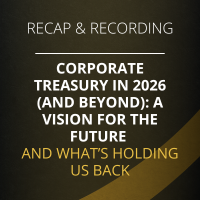Cross-Department Collaboration
One of the key takeaways was the necessity for collaboration across departments beyond treasury and finance. James Leather emphasized that treasury needs to actively engage with other areas of the business. He stated,
“The treasurer needs to understand what the vet (i.e. the business) is doing – and the vet/business should understand what the treasurer is doing . This will not only help the treasurer understand the business and where FX risk is coming from, but also help the business understand how it causes FX risk and who to talk to, to manage it.”
Establishing collaborative working between treasury, sales, procurement and other areas of the business, helps the organisation to manage risk, in a much more holistic – and effective – way.
Valentine Bekhaert added that treasury’s role in facilitating cross-departmental collaboration will only grow.
“I think with digitization, we’re going to see treasury become more of a strategic enabler for the business. The focus will be on using tools to reduce the operational part of the job and enable more strategic conversations.”
Management Support and Risk Oversight
The panelists agreed on the importance of senior management support in FX risk management. Antonio Rami emphasized the treasurer’s responsibility in educating management:
“The tool gives you the resource to tackle the problem. The responsibility of the treasurer is to open the eyes of upper management to why they need investment in that area.”
James Leather further highlighted the need for regular communication between treasury and other key business units.
“It is helpful for the treasurer to have regular discussions with sales and procurement to check that the current method of managing FX risk is still the optimal method,”
he said, stressing the need for early consultation on FX risks.
Additionally, Pieter de Kiewit reinforced that while technology is essential, it can only do so much. He used an analogy to stress this point:
“You can’t blame the hammer for being a bad carpenter’s tool. The training is still essential.”
Recording
Limitations of Manual Methods
Manual methods, particularly Excel, were widely criticized for their limitations. James Leather shared an example of a €70m FX position that was created unnecessarily due to poor processes:
“This was due to a poor process in identifying the risk, and Excel was part of the problem.”
This highlighted the need for improved processes and automation to prevent costly mistakes.
Antonio also pointed out that treasurers need to be proactive when handling FX risks.
“You cannot take such a simplistic approach; you need to be able to quantify the risks and make informed decisions.”
The Strategic Role of Treasury
As treasury increasingly becomes a strategic function, panelists agreed that treasurers should adopt a forward-looking perspective. Valentine Bekhaert noted,
“The focus will be on using tools to reduce the operational part of the job and enable more strategic conversations,”
suggesting that technology will empower treasurers to focus more on long-term strategies. Antonio echoed this sentiment, emphasizing the need for treasurers to adopt a holistic view:
“You need to be proactive. You need to understand. You need to be the right people to bring it and not oversimplify the strategy.”
James Leather shared that good FX risk management can be a competitive advantage for companies. He added,
“Understanding the sources of FX risk is important. Engaging with sales and procurement as to whether the FX risk can be mitigated within commercial contracts is critical.”
Risk Measurement and Management
Identifying and quantifying FX risk are essential steps in managing it. James emphasized the importance of understanding the underlying source of risk:
“The risk should be measured and quantified. All this information will help a treasurer decide how best to manage the risk.”
Pieter de Kiewit emphasized that while tools are crucial, they cannot be the sole solution to FX risk. He said,
“Tooling will help prevent a certain percentage of issues, but it will never be 100% because human insight and strategy are still essential.”
Action Points for Treasurers
Panelists urged treasurers to be proactive in managing FX risks, leveraging technology, and fostering collaboration. James Leather concluded with practical advice for the audience:
“Get out from behind your desk – talk to people – understand the business and the source of the FX risk.”
The session closed with a consensus that treasurers must push for the right tools, promote interdepartmental communication, and ensure senior management understands the importance of FX risk management.
For more treasury insights and best practices, stay connected with treasuryXL.










